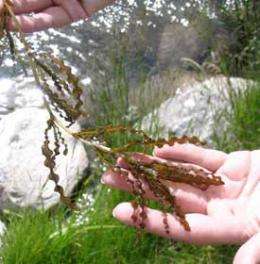Curly-leaf Pondweed found near Bozeman, Montana

(PhysOrg.com) -- In late June, curly-leaf pondweed (Potamogeton crispus), one of Montana's Priority 1 noxious weeds, was found near Bozeman in several ponds along the East Gallatin River drainage system. Priority 1 noxious weeds have limited presence in the state, and require eradication or containment where they are present, with prevention encouraged in areas not yet infested.
Melissa Graves, Plant Identification Diagnostician from Montana State University's Schutter Diagnostic Lab, gave a full description of the invasive aquatic plant that occurs in ponds, lakes, and slower moving streams or rivers.
"Curly-leaf pondweed prefers shallow water depths with a silty, high-nutrient bottom. It is distinguished from native pondweed species by its growth habit and distinctive leaf edges. Unlike native pondweeds, it actively grows in winter, with new plants emerging in spring. The leaves have wavy edges resembling lasagna noodles. They are about one to three inches long, narrow, reddish in color, and translucent, with flattened stems visible through the leaves."
Graves added that curly-leaf pondweed spreads by seed (rarely), by winter buds called turions, and vegetatively as small fragments of plant material attached to boats and other equipment. This invasive aquatic species was introduced to the United States in the late 1800's as an aquarium plant. It spreads easily and can quickly take over bodies of water.
Current distribution records indicate curly-leaf pondweed is present in Flathead, Lake, Lewis & Clark, Sanders, and Valley Counties. However, it may be more widely distributed across the state. Accurate distribution records will improve management of curly-leaf pondweed across the state.
"You can help to update distribution records for this plant by checking any pond, lake, or other water system (e.g. small stream, drainage or irrigation ditch) on your land for its presence," said MSU Extension Invasive Plant Specialist Jane Mangold. "If you think you've found curly-leaf pondweed, please take a sample to your local county Extension agent or weed coordinator."
Samples can also be sent directly to Melissa Graves, Plant Identification Diagnostician, Montana State University Schutter Diagnostic Lab, 119 Plant BioScience Building, Bozeman, Montana, 59717, for confirmation of identity.
Steps to follow to prevent the spread of aquatic invasive plants like curly-leaf pondweed include: thoroughly rinse any mud and debris from all equipment and wading gear and drain the water from your boat before leaving access areas; remove all plant fragments from the boat, propeller, and boat trailer; allow boats or equipment to dry at least five days before transporting them to new bodies of water; do not dispose of aquarium or water garden plants in other bodies of water, seal plants in a plastic bag and place in the trash for disposal.
Provided by Montana State University













